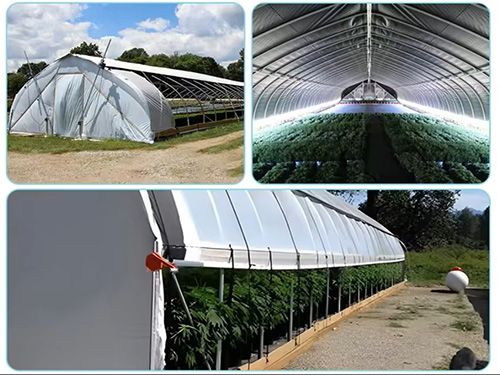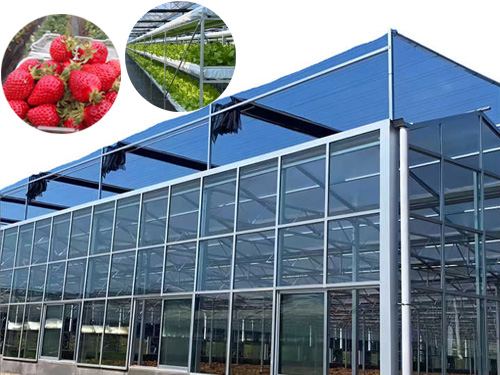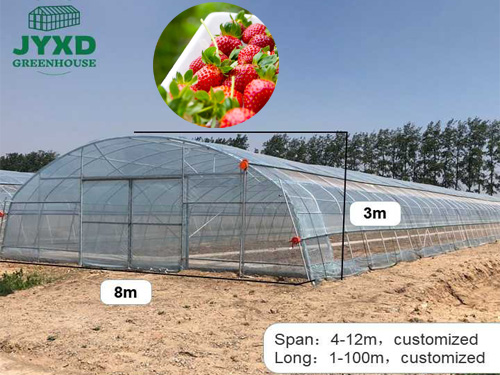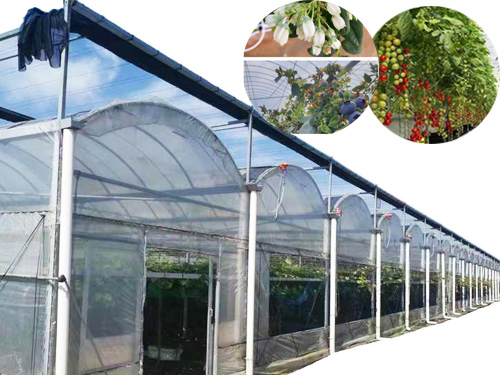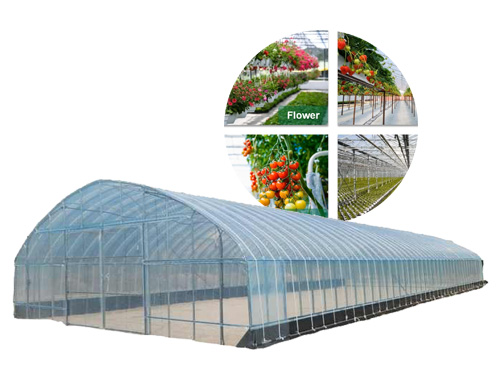NEWS DETAILS
NEWS INFORMATION
Dealing with Harmful Gas Accumulation in Greenhouses: Effective Ventilation and Filtration
AUTHOR:jyxd-greenhouse DATE:2025-03-17 01:57:06 HITS:178
Maintaining optimal air quality in a greenhouse is essential for plant health and growth. While greenhouses provide controlled environments that protect plants from external weather conditions, they can also trap harmful gases that, if not managed properly, can negatively affect both plant development and overall greenhouse conditions. Harmful gases such as carbon dioxide (CO2), ethylene, ammonia, and volatile organic compounds (VOCs) can accumulate and lead to poor air quality, causing stress on plants and increasing the risk of diseases. In this article, we will discuss the sources of harmful gas accumulation in greenhouses and explore effective ventilation and filtration solutions to maintain a healthy environment for your crops.
1. Common Harmful Gases in Greenhouses
Several harmful gases can accumulate inside greenhouses, particularly in enclosed or poorly ventilated spaces. These gases can hinder plant growth, reduce photosynthesis efficiency, and promote the spread of diseases. Understanding the sources of these gases is the first step in addressing the problem.
Carbon Dioxide (CO2)
While plants rely on carbon dioxide for photosynthesis, excessive CO2 levels can be harmful. Elevated CO2 concentrations can occur in greenhouses that are poorly ventilated or in areas where gas is used for supplemental CO2 enrichment. High levels of CO2 can lead to plant stress, stunted growth, or poor fruit production.
Ethylene
Ethylene is a naturally occurring gas that plays a role in plant ripening and aging. However, excessive ethylene can cause premature ripening, wilting, and even damage to certain crops. Ethylene can build up in greenhouses due to decaying plant matter, rotting fruits, or poor ventilation.
Ammonia (NH3)
Ammonia is produced from organic materials such as decomposing plant waste, animal waste, or fertilizers. High ammonia concentrations can be toxic to plants, causing leaf burn, yellowing, and stunted growth. Ammonia buildup is especially common in greenhouses that house animals or use large amounts of nitrogen-based fertilizers.
Volatile Organic Compounds (VOCs)
VOCs are gases emitted from a variety of sources, including paints, pesticides, herbicides, and cleaning agents. High concentrations of VOCs can interfere with plant metabolism, reduce growth rates, and harm sensitive crops. VOCs can also contribute to poor indoor air quality and are harmful to human health in large quantities.
2. The Importance of Proper Ventilation
Effective ventilation is the primary method for controlling harmful gas accumulation in greenhouses. Proper airflow helps to maintain a balance between internal and external air, expelling excess gases and allowing fresh air to enter. There are several ventilation strategies you can implement to improve air quality and control harmful gas levels in your greenhouse.
2.1. Use Natural Ventilation
Natural ventilation utilizes the outdoor air to refresh the greenhouse environment without the need for mechanical systems. This can be achieved by installing roof vents, side vents, or louvered windows that allow hot, stale air to escape and fresh air to enter. The positioning of these vents is crucial for creating a natural airflow, with roof vents at the highest points and side vents positioned lower to allow cooler air to flow in.
The direction of the wind also plays a role in natural ventilation, so the placement of the greenhouse is important to optimize airflow. Using adjustable louvered vents gives you better control over the amount of ventilation based on changing weather conditions.
2.2. Employ Exhaust Fans
In larger greenhouses or in areas with less natural airflow, exhaust fans can assist in removing harmful gases and regulating temperature. Exhaust fans work by pulling hot, humid, and gas-laden air out of the greenhouse, creating a vacuum that allows fresh air to flow in through intake vents. For maximum efficiency, exhaust fans should be placed on the opposite side of the greenhouse from the intake vents, creating a cross-ventilation effect.
2.3. Use Exhaust and Intake Fan Systems with Automation
Automated ventilation systems that integrate exhaust fans and intake vents are highly effective in maintaining a consistent airflow. These systems rely on sensors that monitor temperature, humidity, and gas levels, automatically adjusting the fan speed and vent openings to ensure optimal conditions. By using automated systems, greenhouse operators can maintain a stable environment without the need for manual adjustments.
2.4. Create Airflow Zones
For larger greenhouses, consider dividing the space into zones with separate ventilation systems. This can help target areas where harmful gas accumulation is most likely, ensuring that each section receives proper ventilation. Airflow zones can also help maintain temperature and humidity consistency across the greenhouse.
3. Filtration Systems for Gas Removal
In addition to ventilation, filtration systems can provide an extra layer of protection by removing harmful gases from the air. Here are several filtration options for greenhouse gas control:
3.1. Activated Carbon Filters
Activated carbon filters are highly effective at removing VOCs, ammonia, and other pollutants from the air. These filters use activated carbon, which has a large surface area and can adsorb gases, trapping them before they are released back into the greenhouse. Activated carbon filters are commonly used in greenhouses to control ethylene, VOCs, and ammonia levels.
3.2. Biofilters
Biofilters utilize beneficial microorganisms to break down harmful gases such as ammonia and VOCs. These microorganisms consume the gases, turning them into harmless byproducts. Biofilters are a natural and eco-friendly solution for controlling harmful gas accumulation in greenhouses, and they can be especially useful for organic growers.
3.3. Ozone Generators
Ozone generators are sometimes used in greenhouses to remove harmful gases, particularly ethylene and VOCs. Ozone reacts with and oxidizes pollutants in the air, neutralizing them. However, ozone must be used carefully, as high concentrations of ozone can be harmful to plants. It is essential to regulate ozone generator usage and ensure that the concentration remains within safe limits.
3.4. Air Scrubbers
Air scrubbers use various filtration media, such as activated carbon, UV light, or ozone, to remove harmful gases from the air. These systems are particularly useful for large greenhouses with significant gas buildup. Scrubbers work by circulating air through a filtration system and expelling cleaned air back into the greenhouse.
4. Best Practices for Managing Gas Accumulation
In addition to proper ventilation and filtration, there are several best practices you can follow to minimize harmful gas accumulation in your greenhouse:
• Regularly remove dead plant material and organic waste: Decomposing plant matter is a common source of ammonia and ethylene. Regularly remove any decaying plants to prevent gas buildup.
• Limit the use of chemicals: Reduce the use of pesticides, herbicides, and fertilizers that emit VOCs and other harmful gases. Opt for natural or organic alternatives when possible.
• Monitor air quality: Use gas monitors to keep track of CO2, ethylene, ammonia, and VOC levels. Monitoring allows you to take timely action to prevent gas buildup and ensure a healthy environment for plants.
5. Conclusion
Managing harmful gas accumulation in greenhouses is essential for creating a healthy environment for plants and ensuring optimal growth. Effective ventilation and filtration systems can significantly reduce the risk of harmful gas buildup, improve air quality, and prevent plant stress and diseases. By implementing strategies such as natural ventilation, exhaust fans, automated systems, and filtration options like activated carbon and biofilters, you can ensure that your greenhouse remains a safe and productive space for plant growth. Regular maintenance and monitoring are also critical for maintaining optimal air quality. With the right measures in place, you can create an environment where your plants can thrive without the negative impact of harmful gases.
If you’re looking for high-quality ventilation and filtration systems for your greenhouse, contact us today for expert advice and customized solutions to meet your needs.
Hebei Juyou Xinda Greenhouse Facilities Co.,Ltd.
Copyright © 2024-2025 https://www.jyxd-greenhouse.com. All Rights Reserved Hebei Juyou Xinda Greenhouse Facilities Co.,Ltd.Copyright





 Current Location:
Current Location:


